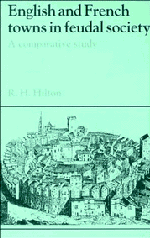Introduction
Published online by Cambridge University Press: 03 May 2011
Summary
The medieval England whose towns I am considering had virtually the same boundaries as those of contemporary England. The same is true of France, with one major exception. The county of Flanders was a fief of the French monarchy, though, as in the case of many other counties and duchies, by no means dominated by the Capetians or the Valois. Most of the county of Flanders is in modern Belgium. Some of the most important towns of medieval Europe were contained within it – Ghent, Ypres, Bruges, as well as many smaller urban centres. The Flemish towns were commercially and industrially to the forefront of the economic, social and political development of northern Europe, especially in the late thirteenth and fourteenth centuries. As historians such as J. Lestocquoy have shown, they are most appropriately compared with the towns of northern Italy. I have therefore taken the view that they were not characteristic of French urban development. In spite of the wealth of primary and secondary material on them, I have not included them in my comparative study.
On the other hand, Provence was not part of the medieval French kingdom until the end of the fifteenth century. Unlike Flanders, however, it was similar in economy and social structure to an important French region – Languedoc – and contained urban centres which have been well studied by French historians. I have therefore included it in my comparative study.
- Type
- Chapter
- Information
- English and French Towns in Feudal SocietyA Comparative Study, pp. 1 - 5Publisher: Cambridge University PressPrint publication year: 1992

